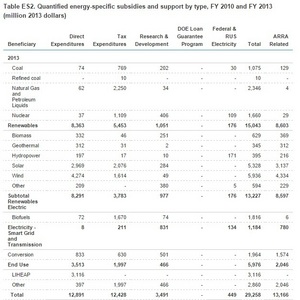EIA report illustrates biofuel, bioenergy subsidies




U.S. Energy Information Administration
March 19, 2015
BY Erin Krueger
On March 12, the U.S. Energy Information Administration published a report on direct federal financial interventions and subsidies in energy for fiscal year (FY) 2103. The report, which responds to a request from Reps. Fred Upton, R-Mich., chairman of the House Committee on Energy and Commerce and Ed Whitfield, R-Ky., chairman of the Subcommittee on Energy and Power, is an update of two earlier EIA reports covering FY 2007 and FY 2010.
Overall, the report finds the total value of direct financial interventions and subsidies in the energy markets decreased by nearly 25 percent between FY 2010 and FY 2013, declining from $38 billion to $29.3 billion. In FY 2010, $11.69 billion in subsidies were electricity related, with $10.7 billion in subsidies for fuels used outside the electricity sector and $15.57 billion in subsidies for conservation, end uses, and the Low-Income Home Energy Assistance Program. In FY 2013, the breakdown included $16.11 billion in electricity-related subsidies, with $5.21 billion in subsidies for fuels used outside the electricity sector and $7.94 billion in subsidies for conservation, end uses, and LIHEAP.
Within the report, the EIA notes that subsidies for fuels used outside the electricity sector experienced substantial decline in both absolute and percentage terms between FY 2010 and FY 2013. The decrease was driven primarily by the elimination of the volumetric ethanol excise tax credit (VEETC). The 45 cent-per-gallon VEETC expired in 2011. In 2010, it was valued at nearly $6 billion.
Advertisement
Advertisement
The report also indicates renewable fuels received 65 percent of the value of direct financial interventions and subsidies in energy markets for fuels not used to produce electricity. Subsidies and support for fuels used outside the electricity sector were $5.2 billion in FY 2013, which accounted for 18 percent of total subsidies and support. Of that amount, the support for biofuels was $1.8 billion, driven mainly by tax expenditures, including the estimated tax expenditure of $1.6 billion for the biodiesel producer tax credit.
In FY 2013, the report notes biomass benefited from $629 million in support, including $332 million in direct expenditures, $46 million in tax expenditures and $251 million in research and development. During the same year, renewables benefited from a total of $15.04 billion, with the majority of that value going to wind and solar. In FY 2010, biomass benefited from $1.3 billion in support, including $178 million in direct expenditures, $551 million in tax expenditures, and $301 million in research and development. In FY 2010, renewables benefited from $5.53 billion in support, with approximately a third of that going to wind. The report also shows that U.S. biomass energy production was 4,272 trillion Btu in FY 2010, increasing to 4,495 trillion Btu in FY 2013. FY 2013 electricity production subsidies and support totaled $16.11 billion, including $118 million for biomass. The support for biomass included $62 million in direct expenditures, $9 million in tax expenditures, and $47 million in research and development.
Advertisement
Advertisement
In 2000, net generation from biomass was 61 billion KWh, dropping to 57 billion KWh in 2013. The share of 2000 generation for biomass was 1.6 percent, dropping to 1.5 percent in 2013.
Outside the power sector, 2.55 quadrillion Btu of biomass and biofuels were produced, increasing to 4.15 quadrillion Btu in 2013. The FY 2013 subsidy and support for biomass and biofuels used outside the electricity sector was $2.33 billion, with biomass and biofuels comprising 9.5 percent of the 2013 share of non-electricity related fuel production. Biomass and biofuel also benefited from 44.7 percent of the non-electricity related subsidies in 2013.
A full copy of the report can be downloaded from the EIA website.
Related Stories
The U.S. Department of Energy Bioenergy Technologies Office (BETO) announced up to $23 million in funding to support research and development (R&D) of domestic chemicals and fuels from biomass and waste resources.
The U.S. DOE has announced its intent to issue funding to support high-impact research and development (R&D) projects in two priority areas: sustainable propane and renewable chemicals and algal system cultivation and preprocessing.
Sens. Sherrod Brown, D-Ohio, and Pete Ricketts, R-Neb., in August introduced the Renewable Chemicals Act, a bill that aims to create a tax credit to support the production of biobased chemicals.
The Chemical Catalysis for Bioenergy Consortium, a consortium of the U.S. DOE’s Bioenergy Technologies Office, has launched an effort that aims to gather community input on the development of new biomass processing facilities.
USDA on March 8 celebrated the second annual National Biobased Products Day, a celebration to raise public awareness of biobased products, their benefits and their contributions to the U.S. economy and rural communities.
Upcoming Events










